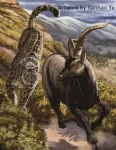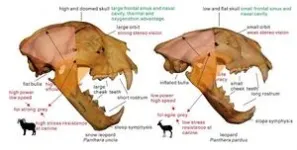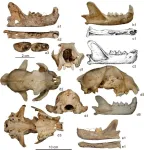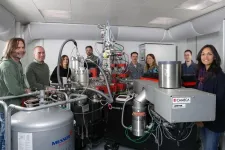(Press-News.org) The study, published in Science Advances, was led by researchers Qigao Jiangzuo, from Peking University, and Joan Madurell Malapeira, from the Universitat Autònoma de Barcelona (UAB).
Snow leopards (Panthera uncia) are in serious danger of extinction, with only about 4,000 specimens remaining. They are medium to large felids that live at high altitudes, over 2,000 meters above sea level, mainly in the Himalayas. Although their distinctive traits have long been recognized, the correlation between these traits and their adaptation to the Tibetan plateau environment, as well as their evolutionary history, remained largely unexplored due to the total absence of fossil records in Tibet and surrounding regions. Until now, possible unverified remains had been located in northern China and in Europe, but their validation and phylogenetic position remained uncertain.
In the study now published, researchers reviewed a large amount of samples assigned to the common leopard (Panthera pardus) from Europe and Asia and for the first time identified five snow leopard fossils. The records, from China, France and Portugal, date from one million years ago. This allowed them to trace the evolution and ecological adaptation of the species during the Quaternary, as well as to model its possible geographic and temporal dispersion. The research integrated morphometric and phylogenetic analyses, as well as mathematical models of species distribution.
The study highlights the unique traits that set snow leopards apart from their more common cousins. While common leopards are built to hunt swift and agile prey in partially forested habitats, snow leopards have evolved distinct features to dominate the rugged mountain landscapes. These include larger teeth, domed skulls, and stronger jaws and paws—perfect for taking down robust, muscular prey like mountain goats.
But their survival in rocky, barren terrains also relied on other key adaptations. Enhanced binocular vision, a large cranial ectotympanic structure for better hearing, powerful limbs to withstand the impact of steep jumps, and a long tail for balance developed rapidly during the Quaternary, particularly from the Middle Pleistocene onward, about half a million years ago.
These key adaptations coincided with the colder phases of the last Ice Ages, in which snow leopards expanded beyond the Himalayas into central China and, in a surprising twist, researchers remark, dispersed westward to the Iberian Peninsula. In the early 2000s, amateur speleologists uncovered in Porto de Mós, Portugal, a remarkable fossil: a partial leopard skeleton, including an almost perfectly preserved skull, known as the "leopard of Algar da Manga Larga”. This fossil has been now revealed to be an unexpected member of the snow leopard lineage in Western Europe.
“We propose that about 900,000 years ago the gradual intensification of glaciations in Eurasia led to the gradual appearance of more open spaces, and this made possible the arrival of the species in Portugal, where it lived until relatively recently, about 40,000 years ago,” says Joan Madurell Malapeira, researcher at the UAB’s Department of Geology.
The discovery of the Portugal fossil has significant implications for the conservation of snow leopards. The study suggests that snow leopards prioritize steep, rocky terrain and cold climates over high altitudes, challenging long-held assumptions about their habitat preferences.
“The analyses we have carried out lead us to conclude that surely the high altitude and snow would not have been the limiting factor for the distribution of the species, but rather the presence of open and steep spaces. In other words, the snow leopard has always been adapted to live in the mountains, but not necessarily at high altitudes and with snow. And this, in a context of climate change like the current one, is encouraging to ensure their survival,” says Joan Madurell Malapeira.
Future research will explore the neuroanatomy and ecology of Algar da Manga Larga leopard, shedding more light on the fascinating history of this iconic mountain predator.
END
Conquest of Asia and Europe by snow leopards during the last Ice Ages uncovered
New study identifies an unexpected member of the species' evolutionary lineage in Portugal and challenges traditional assumptions about its habitat preferences
2025-01-15
ELSE PRESS RELEASES FROM THIS DATE:
Researchers make comfortable materials that generate power when worn
2025-01-15
Researchers have demonstrated new wearable technologies that both generate electricity from human movement and improve the comfort of the technology for the people wearing them. The work stems from an advanced understanding of materials that increase comfort in textiles and produce electricity when they rub against another surface.
At issue are molecules called amphiphiles, which are often used in consumer products to reduce friction against human skin. For example, amphiphiles are often incorporated into diapers to prevent chafing.
“We set out to develop a model that would give us ...
Study finding Xenon gas could protect against Alzheimer’s disease leads to start of clinical trial
2025-01-15
Most treatments being pursued today to protect against Alzheimer’s disease focus on amyloid plaques and tau tangles that accumulate in the brain, but new research from Mass General Brigham and Washington University School of Medicine in St. Louis points to a novel—and noble—approach: using Xenon gas. The study found that Xenon gas inhalation suppressed neuroinflammation, reduced brain atrophy, and increased protective neuronal states in mouse models of Alzheimer’s disease. Results are published in Science Translational Medicine, and a phase 1 clinical trial of the treatment in healthy volunteers will begin in early 2025.
“It ...
Protein protects biological nitrogen fixation from oxidative stress
2025-01-15
A small helper for big tasks: an oxygen sensor protein protects the enzymatic machinery of biological nitrogen fixation from serious damage. Its use in biotechnology could help to reduce the use of synthetic fertiliser in agriculture in the future. A research team led by biochemist Prof. Dr Oliver Einsle from the Faculty of Chemistry and Pharmacy and the Centre for Biological Signalling Studies (BIOSS) at the University of Freiburg has discovered exactly how the so-called Shethna protein II works. The scientists used the newly established cryo-electron microscopy in Freiburg. ...
Three-quarters of medical facilities in Mariupol sustained damage during Russia’s siege of 2022
2025-01-15
Three-quarters of medical facilities in Mariupol sustained damage during Russia’s siege of 2022, with some evidence that the attacks may have been intentionally targeted, per study using satellite imagery.
####
Article URL: https://journals.plos.org/globalpublichealth/article?id=10.1371/journal.pgph.0003950
Article Title: The effect of conflict on damage to medical facilities in Mariupol, Ukraine: a quasi-experimental study
Author Countries: Germany, United States
Funding: This work was supported ...
Snow leopard fossils clarify evolutionary history of species
2025-01-15
The snow leopard (Panthera uncia) is a large feline unique to the Qinghai-Tibet Plateau and its surrounding areas. As the apex predator in the region, the snow leopard plays a crucial role in maintaining ecological stability. Its unique characteristics, coupled with its striking appearance, have made it a flagship species for conservation efforts aimed at protecting the ecosystem of the Qinghai-Tibet Plateau.
Unfortunately, few snow leopard fossils have been found in the Qinghai-Tibet Plateau region, particularly fossils from the Quaternary period. As a result, it’s unclear how snow leopards evolved their specialized adaptations to this environment.
On the one hand, molecular ...
Machine learning outperforms traditional statistical methods in addressing missing data in electronic health records
2025-01-15
Researchers from the National Institute of Health Data Science at Peking University and the Department of Clinical Epidemiology and Biostatistics at Peking University People's Hospital have conducted a comprehensive systematic review evaluating strategies for addressing missing data in electronic health records (EHRs). Published in Health Data Science, the study highlights the growing importance of machine learning methods over traditional statistical approaches in managing missing data scenarios effectively.
Electronic health records have become a cornerstone in modern healthcare research, enabling analysis across clinical trials, treatment effectiveness studies, and ...
AI–guided lung ultrasound by nonexperts
2025-01-15
About The Study: In this multicenter validation study, trained health care professionals with artificial intelligence (AI) assistance achieved lung ultrasound images meeting diagnostic standards compared with lung ultrasound experts without AI. This technology could extend access to lung ultrasound to underserved areas lacking expert personnel.
Corresponding Author: To contact the corresponding author, Cristiana Baloescu, MD, MPH, email cristiana.baloescu@yale.edu.
To access the embargoed ...
Prevalence of and inequities in poor mental health across 3 US surveys
2025-01-15
About The Study: This survey study documents increasingly prevalent poor mental health from 2011 to 2022 across multiple U.S. health surveys, with notable prevalence differences in Behavioral Risk Factor Surveillance System and National Survey on Drug Use and Health vs National Health Interview Survey. Inequities in these outcomes by age, sex, and racial and ethnic group were often sizeable and changed over time in distinct ways, consistent with findings in prior literature.
Corresponding Author: To contact the corresponding ...
Association between surgeon stress and major surgical complications
2025-01-15
About The Study: In this cohort study including 38 attending surgeons and 793 patients, increased surgeon stress at the beginning of a procedure was associated with improved clinical patient outcomes. The results are illustrative of the complex relationship between physiological stress and performance, identify a novel association between measurable surgeon human factors and patient outcomes, and may highlight opportunities to improve patient care.
Corresponding Author: To contact the corresponding author, Jake Awtry, MD, email jawtry@bwh.harvard.edu.
To access the embargoed study: Visit our For The Media ...
How cryogenic microscopy could help strengthen food security
2025-01-15
According to the United Nations, soil salinization affects between 20% and 40% of arable land globally, with human activity and climate change – especially rising sea levels – largely responsible for this process. While the human body needs sodium to function, this is not the case for most plants. In fact, excess salt around plants’ roots gradually blocks their access to water, stunting their growth, poisoning them and hastening their death. Ten million hectares of farmland are destroyed by soil salinization every year, posing a threat to global food security.
Scientists at EPFL, ...
LAST 30 PRESS RELEASES:
Strategic river sensors could have forewarned of Texas Camp flood disaster
Drone sampling of whale breath reveals first evidence of potentially deadly virus in Arctic
Roman soldiers defending Hadrian’s Wall infected by parasites, study finds
Pinochet’s prisoners were tormented with music but still found solace in it, a new book reveals
Fertility remains high in rural Tanzania despite access to family planning
AI-assisted device can improve autism care access
Kinetic careers
Uncovering how parasitic plants avoid attacking themselves to improve crop resistance
Nanoparticle vaccine strategy could protect against Ebola and other deadly filoviruses
Study finds brain care score can predict risk of stroke across racial groups
Key lung immune cells can intensify allergic reactions
Do hormones explain why women experience more gut pain?
New materials conduct ions in solids as easily as in liquids
Breakthrough of the Year: Renewable energy begins to eclipse fossil fuel-based sources
LLM use is reshaping scientific enterprise by increasing output, reducing quality and more
Introducing LightGen, a chip for ultra-fast, ultra-efficient generative AI
Astronomers see fireworks from violent collisions around nearby star
ACC/AHA issue new guideline on managing congenital heart disease in adults
Cosmic crash caught on camera
Is talented youth nurtured the wrong way? New study shows: top performers develop differently than assumed
Ants: An untapped resource in the development of antibiotics?
Archaeologists use AI to create prehistoric video game
Mitochondria migrate toward the cell membrane in response to high glucose levels
Tiny viral switch offers hope against drug-resistant bacteria
Most parents aware of early peanut introduction guidelines, but confused about details
HPV vaccine can protect against severe lesions of the vulva and vagina
Virtual care provision and emergency department use among children and youth
Quadrivalent HPV vaccine and high-grade vulvovaginal lesions
Insights into dry eyes gained from stem cell-derived tear glands
Researchers identify 166 human pluripotent stem cell lines available for use in clinical applications
[Press-News.org] Conquest of Asia and Europe by snow leopards during the last Ice Ages uncoveredNew study identifies an unexpected member of the species' evolutionary lineage in Portugal and challenges traditional assumptions about its habitat preferences






